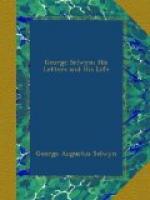* Horace Walpole to H. S. Conway, Florence, March 25, 1741.
* Bedford Correspondence, vol. iii. P. 206.
The charming country estate and house which he had inherited from his father had little attraction for Selwyn, and to the end of his life, if he could not be in town, he preferred Castle Howard, or indeed any house where he would meet with congenial spirits. “This is the second day,” he once wrote to Carlisle, “I am come home to dine alone, but so it is, and if it goes on so I am determined to keep a chaplain, for although I do not stand in need of much society, I do not relish being quite alone at this time of day.”
All this time he was a Member of Parliament. There is a little village of small red cottages with thatched roofs lying among the Wiltshire downs between Savernake Forest and Andover. It is called Ludgershall, and has a quiet out-of-the-world look. In the eighteenth century it was a pocket borough, returning two Members to Parliament, and was the property of the Selwyn family. The representation was as much in their hands as the trees in the adjoining fields. In 1747 George Selwyn had found it convenient to enter the House of Commons. In Ludgershall there were no constituents to take him to task; to be able to go to Westminster when he wished added to the variety of life. It kept him in touch with the politicians and statesmen of St. James’s Street, and it made him a marketable quantity—his price was another sinecure, the place of Paymaster of the Works. But this he did not receive until he had inherited the family property, which gave him a hold on the city of Gloucester. For this city he was a Member from 1754 to 1780, when, losing his seat at the general election, he gladly returned to his former constituency. The seat at Ludgershall was never in the nature of a true political representation, and even when Member for Gloucester Selwyn seems to have attended but little to the House of Commons. He was one of a legion of sinecures—a true specimen of the place-man of the age. Possessed of some political influence, he was able to find in




